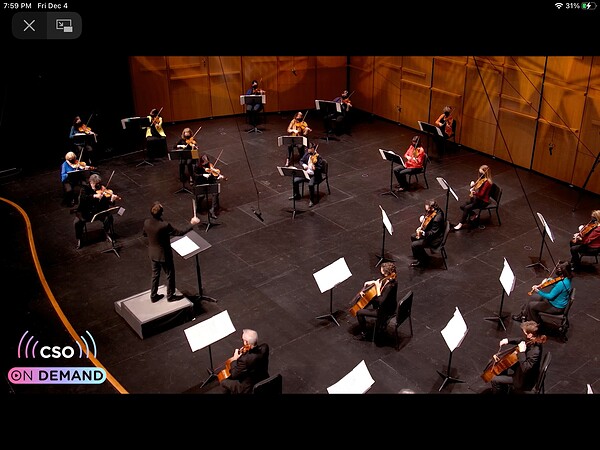Review
The CSO Demonstrates Resilience Through "CSO On Demand"

The CSO Demonstrates Resilience Through "CSO On Demand"
By Cecilia Whalen
November 6, 2020 - Charlotte, NC
Coping with crisis
Like many performing arts organizations, the Charlotte Symphony's 20-21 season has been forced out of the theater and into the unknown. In response to the times; the orchestra has recently adapted with an array of virtual musical offerings to sustain itself and its viewers throughout the uncertain days of the pandemic. In addition to a few socially distanced outdoor concerts, the orchestra's current programs include "#CSOatHome" – a collection of free audio streams of past performances, listening guides, and more, available through its website – as well as "CSO On Demand," a program of newly recorded concerts streamed with ticket purchase. "CSO On Demand," a four-concert series which began streaming on Oct. 23, premiered its second digital concert featuring the music of John Williams, Aaron Copland, and Mark O'Connor (among many others) this past week on Nov. 6.
Recorded in Charlotte's Knight Theater, the orchestra presented just the strings (for obvious reasons), a pianist, and a percussionist, all of whom were masked and spaced across the stage. Directed by resident conductor Christopher James Lees, the orchestra played ten brief, light pieces, including Copland's "Hoe Down" from Rodeo, two Irish tunes by Percy Grainger, and a John Williams trilogy of themes from Star Wars, Raiders of the Lost Ark, and Jurassic Park.
Production quality of the concert was high, both sound-wise and visually, as multiple viewing angles were provided through smooth transitions, and the sound was clear (at least as heard through my personal laptop). The CSO strings were bright and playful in "Hoe Down," triumphant in the Williams trilogy, and full of pluck (both literally and figuratively) in Leroy Anderson's "Jazz Pizzicato." In "Appalachia Waltz," a piece by former CSO composer-in-residence Mark O'Connor, the orchestra demonstrated soft and legato sounds inspired by the mountain region.
It was an interesting experiment to feature so many vignettes of music in one concert, likely an attempt to be sensitive to virtual attention spans. However, because each piece was so brief – the concert lasted 45 minutes total – it was difficult to invest in any piece or get into any kind of listening groove. Instead of the cohesive and complete musical experience that one often finds when attending a symphony concert, the listener was given only little tastes of many different possible experiences, which left the program feeling more like a teaser than a full performance. The 45-minute length is probably appropriate for an online concert, but that being said, perhaps the ten-piece program went a little too far in the attempt to stay light or undemanding. The remaining two "CSO On Demand" concerts focus on fewer, longer pieces within the 45-minute time frame; I feel that this may have a better result in producing a fulfilling experience.
This vignette-style programming is just one example of the many experiments performing arts organizations are attempting as the pandemic persists. The virtual platform, in of itself, is an experiment, and its use raises many important questions about what we call the performing arts experience. For example, this particular "On Demand" model allows patrons to purchase access to each concert for an entire week, beginning the day of the premiere. In this way, viewers can work around their own schedules, and they also have the chance for repeat viewing, two things not guaranteed when performances are live. Conversely, this model seems to remove any kind of communal viewing experience as well as an inherent connection to the present, two things definitive of the performing arts. Live-streamed performances, the other major virtual model that many organizations have been using recently, where viewers tune in at one time only, better retains this communal aspect of performances by providing a comment section or chat feature through their social media streaming platforms; additionally, the concerts occupy only the time frame in which they are streamed, thus maintaining a relationship to the present.
Clearly no virtual platform will ever recreate the live experience; so I guess the question is: Is it better to try to get as close as possible to something that will never be the same, or to see that attempt as futile and instead decide to produce a new experience, altogether? Should the virtual try to replace real life as best it can, or should it occupy an entirely different and unique role? Performing artists have been considering these questions since March, but they remain up to interpretation. Even after the pandemic ends, the questions will persist. (With any luck, we won't be living at the mercy of their answers for much longer.)
Despite the hinderances of the online platform, all attempts to keep the arts alive and accessible are vital, and the participation and support of patrons is, too. The Charlotte Symphony "On Demand" demonstrates the persistence and resilience of the arts and artists and the organization's commitment to its musicians, as well as its listening community. "Williams, Copland, + O'Connor" is available through Nov. 13.